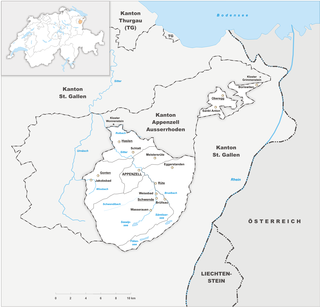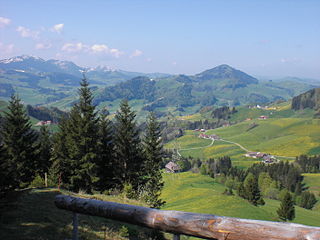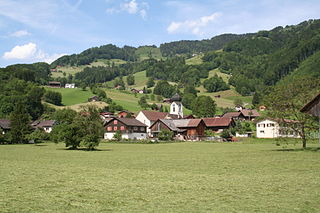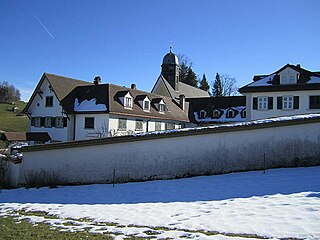
Appenzell Innerrhoden, in English sometimes Appenzell Inner-Rhodes, is one of the 26 cantons forming the Swiss Confederation. It is composed of six districts. The seat of the government and parliament is Appenzell. It is traditionally considered a "half-canton", the other half being Appenzell Ausserrhoden.

Appenzell Ausserrhoden, in English sometimes Appenzell Outer Rhodes, is one of the 26 cantons forming the Swiss Confederation. It is composed of twenty municipalities. The seat of the government and parliament is Herisau, and the seat of judicial authorities are in Trogen. It is traditionally considered a "half-canton", the other half being Appenzell Innerrhoden.

Urnäsch is a municipality in the canton of Appenzell Ausserrhoden, Switzerland.

Herisau is a municipality and the capital of the canton of Appenzell Ausserrhoden in Switzerland. It is the seat of the canton's government and parliament; the judicial authorities are situated in Trogen.
Stein is a municipality in the canton of Appenzell Ausserrhoden in Switzerland.

Trogen is a municipality in the canton of Appenzell Ausserrhoden in Switzerland. The town is the seat of the canton's judicial authorities.

Walzenhausen is a municipality in the canton of Appenzell Ausserrhoden in Switzerland.

Reute is a municipality in the canton of Appenzell Ausserrhoden in Switzerland.

Schlatt-Haslen District is a district of the canton of Appenzell Innerrhoden in Switzerland. It was formally established in 1872 from the rhode Schlatt and the village Haslen.
Oberegg District is a district in the canton of Appenzell Innerrhoden in Switzerland. It comprises three small exclaves of the canton, a few kilometers northeast of the rest of Appenzell Innerrhoden.

Appenzell was a canton in the northeast of Switzerland, and entirely surrounded by the canton of St. Gallen, in existence from 1403 to 1597.

St. Gallen is a Swiss city and the capital of the canton of St. Gallen. It evolved from the hermitage of Saint Gall, founded in the 7th century. Today, it is a large urban agglomeration and represents the center of eastern Switzerland. Its economy consists mainly of the service sector. The city is home to the University of St. Gallen, one of the best business schools in Europe.

Appenzell District is a district of the canton of Appenzell Innerrhoden in Switzerland. It has a population of 5,793. The area of Appenzell is 16.88 km2 (7 sq mi). The district of Appenzell consists of a part of the village Appenzell, as well as Rinkenbach, Kau and Meistersrüte.

Guttannen is a municipality in the Interlaken-Oberhasli administrative district in the canton of Bern in Switzerland.

Jaun is a municipality in the district of Gruyère in the canton of Fribourg in Switzerland. It is the only German-speaking municipality in Gruyère.

Degersheim is a municipality in the Wahlkreis (constituency) of Wil in the canton of St. Gallen in Switzerland.

Schänis is a municipality in the Wahlkreis (constituency) of See-Gaster in the canton of St. Gallen in Switzerland.

Bivio is a village and former municipality in the Sursés in the district of Albula of the Swiss canton of Graubünden. On 1 January 2016 the former municipalities of Bivio, Cunter, Marmorera, Mulegns, Riom-Parsonz, Salouf, Savognin, Sur and Tinizong-Rona merged to form the new municipality of Surses.

Wonnenstein Friary or Mary's Rose Garden Wonnenstein is a monastery of Sisters of the Third Order of Saint Francis in Teufen in the canton of Appenzell Ausserrhoden in Switzerland. While it is located in Appenzell Ausserrhoden, the buildings and grounds are a small exclave of the canton of Appenzell Innerrhoden.

Grimmenstein Monastery is a monastery of Sisters of the Third Order of Saint Francis in Walzenhausen in the canton of Appenzell Ausserrhoden in Switzerland. While it is located in Appenzell Ausserrhoden, the buildings and grounds are a small exclave of the canton of Appenzell Innerrhoden.
























